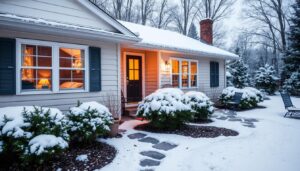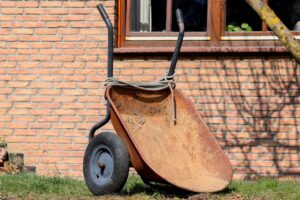As the temperatures start to drop and the winter chill sets in, it’s time to take action and ensure your home’s exterior and garden are well-prepared for the harsh conditions. But do you know where to start? This comprehensive guide will provide you with all the essential tips and tricks to winter-proof your property, keeping it safe, secure, and weathering the storm with ease.
Is your home truly ready for the chilly months ahead? From inspecting your roof to insulating your pipes, this handyman’s guide covers the crucial steps to protect your most valuable asset – your home. Whether you’re a seasoned DIY enthusiast or a first-time homeowner, you’ll discover practical, cost-effective solutions to winterise your property and maintain its curb appeal throughout the winter season.
So, let’s dive in and explore the essential winter-proofing tasks that will give you peace of mind and ensure your home stands strong against the winter elements. Get ready to roll up your sleeves and transform your property into a winter wonderland that’s ready to withstand the season’s harshest conditions.
Why Winter-Proofing Matters for Your Home
As the colder months approach, the importance of properly winterproofing your home’s exterior and garden becomes increasingly evident. By taking the time to prepare your property, you can safeguard it against the harsh winter elements and reap numerous benefits that make the effort well worth it.
One of the primary reasons to focus on winterproofing is the importance of home winterproofing. Neglecting to winterise your home can lead to costly damage, such as burst pipes, leaky roofs, and drafty windows, all of which can be not only inconvenient but also financially burdensome to repair. Investing in winterproofing measures can help you avoid these issues and protect your home’s structural integrity.
Moreover, the benefits of winterising your home extend beyond damage prevention. Properly insulating your property and sealing any air leaks can also contribute to significant energy savings, as you’ll be able to maintain a comfortable indoor temperature with less heating required. This, in turn, can lead to lower utility bills throughout the colder months, making winterproofing a cost-effective investment.
On the flip side, the risks of not winterising your home are considerable. Failing to prepare your home for winter can expose it to water damage, structural issues, and even safety hazards, such as icy walkways or falling tree branches. These problems can not only be disruptive to your daily life but also pose potential threats to the well-being of your family and property.
In conclusion, the importance of winterproofing your home’s exterior and garden cannot be overstated. By taking the necessary steps to prepare your property for the winter months, you can protect your investment, save on energy costs, and enjoy a more comfortable living environment throughout the colder season.
Inspect and Repair Your Roof
As the first line of defence against winter weather, your roof requires thorough inspection and repairs before the cold season sets in. Start by carefully examining your roof for any damaged or missing shingles, and replace them promptly to maintain its integrity. Neglecting winterproofing your roof can lead to costly issues down the line, so it’s essential to address any roof repairs before winter.
Next, take a close look at your chimneys and vents, ensuring they are properly sealed and functioning correctly. Any cracks or gaps around the roof should be sealed to prevent water and cold air from infiltrating your home. Proper roof maintenance for winter is crucial to safeguarding your property against the harsh elements.
By taking the time to inspect and repair your roof before winter, you can help to safeguard your home and minimise the risk of costly damages. Regular roof maintenance, such as addressing issues like missing shingles or faulty chimneys, can go a long way in winterproofing your roof and ensuring your home is ready to withstand the colder months ahead.
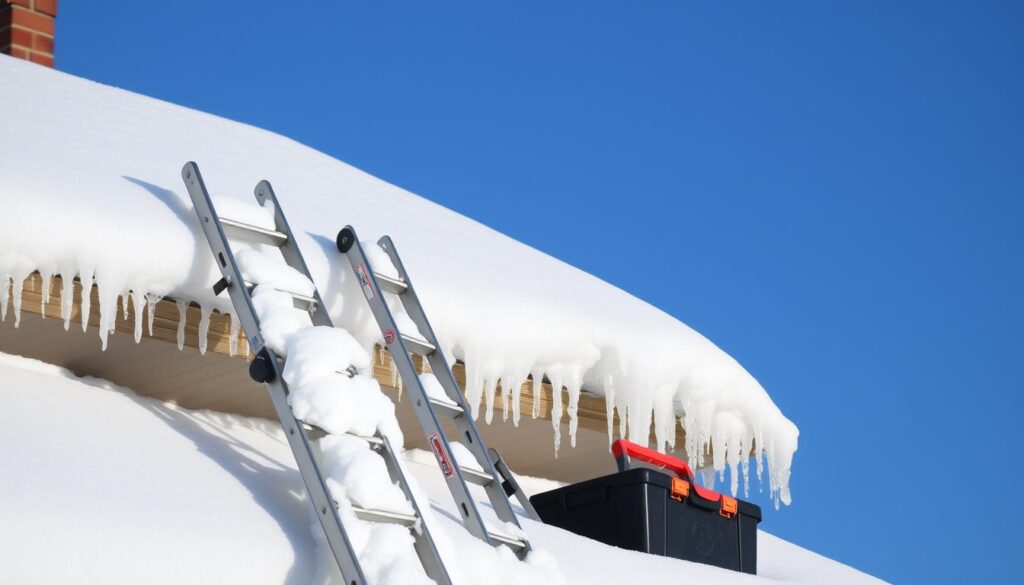
Seal Windows and Doors
As the cooler months approach, it’s crucial to focus on winterproofing your home’s windows and doors. These openings can be a common entry point for cold draughts and air leaks, which can significantly impact your home’s energy efficiency and comfort levels. By taking the time to properly seal and insulate these areas, you can enjoy a cosier, more energy-efficient home throughout the winter.
First, conduct a thorough inspection of your windows and doors, looking for any cracks, gaps or spaces that could allow cold air to seep in. Use a caulking gun to seal any small crevices, and apply weather-stripping around the edges of doors and operable windows. This simple DIY window and door weatherproofing task can make a remarkable difference in keeping the warm air inside and the cold air outside.
Consider taking the extra step of applying insulation film to your windows. These transparent, adhesive films create an additional barrier against the elements, helping to maintain the desired temperature in your home. This cost-effective solution is an easy way to improve your winterproofing efforts and reduce your energy bills.
By dedicating some time to sealing air leaks around your windows and doors, you’ll be well on your way to a more comfortable and energy-efficient home this winter. Remember, small investments in winterproofing can yield significant long-term savings and a more enjoyable living environment.
Insulate Exterior Walls and Attic
When it comes to maintaining a cosy and energy-efficient home during the winter months, proper insulation is key. Start by assessing the insulation levels in your exterior walls and attic, and make any necessary improvements. Upgrading your attic insulation and adding insulation to exterior walls can significantly reduce heat loss and lower your energy bills.
One of the most effective ways to improve home insulation for winter is to focus on your attic. Over time, attic insulation can become compressed or damaged, reducing its effectiveness. Consider adding extra layers of insulation to boost the R-value, which measures an insulation material’s resistance to heat flow. This can make a noticeable difference in keeping your home warm and toasty.
For exterior walls, you have several options for improving insulation. If your home was built with cavity walls, you can have them filled with blown-in insulation, such as cellulose or fiberglass. This can be an effective DIY insulation project that helps retain heat and reduce drafts. Alternatively, you can add rigid foam insulation to the exterior walls, which provides a continuous thermal barrier.
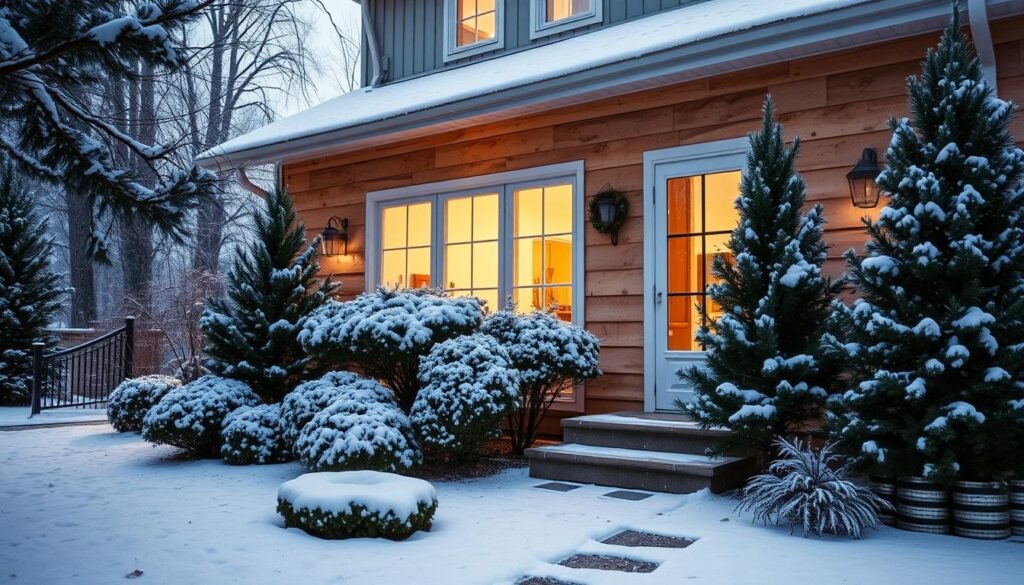
Remember, investing in home insulation for winter is a smart move that can pay off in the long run. Not only will it keep your home more comfortable, but it can also lead to significant savings on your energy bills. So, take the time to assess your insulation needs and explore the various DIY insulation projects that can help you stay warm and cosy all winter long.
Prepare Your Gutters and Downspouts
As the colder months approach, it’s crucial to ensure your home’s gutters and downspouts are properly prepared for the winter season. Winterproofing gutters and downspouts is a vital step in maintaining the integrity of your property and protecting it from water damage.
Begin by inspecting your gutters and downspouts for any debris, such as leaves, twigs, or other materials that may have accumulated over the year. Clearing out these obstructions is essential to ensure proper water drainage and prevent ice dams from forming during the winter.
- Thoroughly clean your gutters, removing all debris and ensuring they are free of any clogs or blockages.
- Inspect the gutters and downspouts for any cracks, holes, or loose connections, and make the necessary repairs to ensure a watertight system.
- Align the gutters and downspouts to ensure they are directing water away from your home’s foundation and preventing water from pooling around the property.
Preparing your gutters and downspouts for the winter months is a crucial step in winterproofing your home’s exterior. By taking the time to maintain and repair these essential components, you can help protect your property from the damaging effects of water and ice, ultimately saving you time and money in the long run.
Handyman’s Guide to Winter Proofing Your Outdoor Faucets and Pipes
As the colder months approach, it’s crucial to give special attention to your home’s outdoor faucets and pipes. These vulnerable components are susceptible to freezing temperatures, which can lead to costly water damage. As a dedicated handyman, you’ll want to follow these essential steps to winter-proof your outdoor plumbing and avoid any unwelcome surprises.
First and foremost, insulating your outdoor faucets is a must. This simple task can make all the difference in protecting them from the harsh winter chill. Next, you’ll want to drain and shut off the water supply to any exterior pipes. This prevents water from freezing and potentially bursting the pipes.
- Insulate outdoor faucets to prevent freezing
- Drain and shut off water supply to exterior pipes
- Install heated pipe covers for added protection
For an extra layer of protection, consider installing heated pipe covers. These ingenious devices use low-voltage electricity to maintain a safe temperature and keep your pipes from freezing, even in the most extreme conditions. With a bit of DIY know-how, you can easily winterproof your outdoor faucets and pipes, safeguarding your home against the ravages of winter.
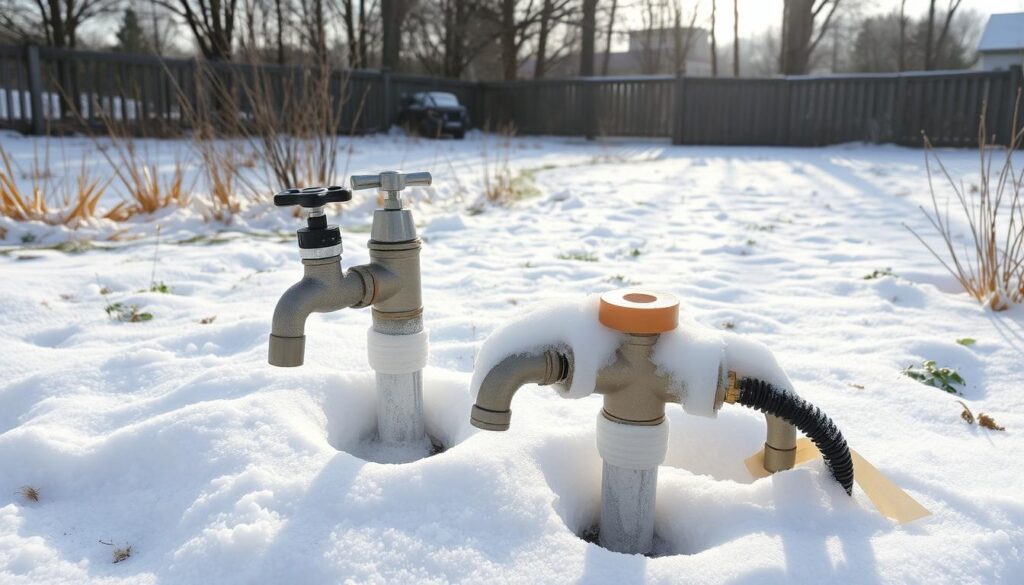
By taking the time to properly winterproof your outdoor plumbing, you’ll be able to rest easy knowing that your home is well-prepared for the colder months ahead. Remember, a little proactive maintenance can go a long way in protecting your pipes from freezing and preventing costly water damage.
Protect Your Garden and Landscaping
As the winter months approach, it’s important to pay special attention to your home’s exterior landscaping. Winterproofing your garden and preparing your landscaping for the colder weather is crucial to ensure your outdoor spaces thrive once spring arrives.
One of the most important steps in protecting your plants is to cover any delicate varieties with protective coverings. This helps shield them from the damaging effects of frost and heavy snowfall. Additionally, applying a thick layer of mulch around the base of shrubs and throughout your flower beds can insulate the soil and provide added protection for your plants’ roots.
Pruning your trees and shrubs is also a crucial task when preparing your landscaping for winter. Remove any dead or damaged branches, as these can be vulnerable to breaking under the weight of snow and ice. This not only safeguards your plants but also helps to maintain the overall aesthetic of your outdoor spaces.
By taking the time to properly winterproof your garden and landscaping, you can rest assured that your home’s exterior will be ready to face the harsh winter conditions. These simple steps will help protect your plants and ensure your outdoor areas thrive when the warmer weather returns.
Exterior Maintenance Checklist
As the colder months approach, it’s crucial to ensure your home’s exterior is properly prepared to withstand the winter weather. This comprehensive winter home maintenance checklist will guide you through the essential steps to safeguard your property and keep it in top condition throughout the season.
Start by inspecting your roof for any damage or missing shingles. Repair any issues to prevent leaks and prevent further deterioration. Next, seal any cracks or gaps around your windows and doors to improve energy efficiency and prevent cold air from seeping in.
Don’t forget to insulate your exterior walls and attic to retain heat and reduce your energy costs. Cleaning and maintaining your gutters and downspouts is also crucial to ensure proper drainage and prevent ice dams from forming.
For your outdoor plumbing, shut off the water supply to exterior faucets and pipes, and insulate any exposed pipes to prevent them from freezing. Finally, protect your garden and landscaping by mulching plants, covering delicate vegetation, and ensuring your lawn mower and other tools are properly stored.
By following this exterior home winterproofing checklist, you’ll be well on your way to preparing your home for the winter season. Remember, a little DIY winter home prep now can save you from costly repairs down the line.
Cost-Effective Winter-Proofing Tips
Preparing your home for winter doesn’t have to put a strain on your budget. Discover a range of budget-friendly winterproofing strategies that can help you save money while keeping your home cosy and energy-efficient.
Start by prioritising the high-impact projects that will provide the most significant return on your investment. Tackle tasks like sealing windows and doors, insulating your attic, and winterising outdoor faucets and pipes. These cost-saving home winterproofing measures can make a big difference in reducing your energy bills.
Embrace your inner DIY spirit and explore ways to tackle some of the winterproofing tasks yourself. DIY winter home prep on a budget can help you save on labour costs while giving you a sense of accomplishment. From caulking gaps to installing weather stripping, there are plenty of budget-friendly winterproofing projects you can tackle with a little elbow grease.
Don’t forget to research any available rebates or incentives that can help offset the expenses of your budget-friendly winterproofing efforts. Many local authorities and utility companies offer programmes to encourage energy-efficient home improvements, so be sure to explore these cost-saving options.
By prioritising high-impact projects, embracing DIY techniques, and taking advantage of available rebates, you can enjoy a cosy, energy-efficient home this winter without breaking the bank.
Conclusion
By following the comprehensive steps outlined in this Handyman’s Guide to Winter-Proofing Your Home’s Exterior and Garden, you can ensure your property is well-protected against the harsh winter months. The importance of winterising your home cannot be overstated, as it helps safeguard your investment and enhance your overall comfort throughout the colder season.
From inspecting and repairing your roof to insulating your exterior walls and attic, the summary of winter home prep covered in this guide equips you with the necessary knowledge and tools to tackle the essential tasks. By sealing windows and doors, preparing your gutters and downspouts, and protecting your outdoor faucets and pipes, you can effectively prevent costly damage and maintain the integrity of your home.
As you take the next steps for winterproofing, remember that a little time and effort now can save you from a world of headaches later. Invest in your home’s well-being, and enjoy the peace of mind that comes with a well-protected property throughout the winter months.

Don’t hesitate to tackle these winter-proofing projects – your home and your wallet will thank you. Take action today and ensure your property is ready to withstand the elements, so you can sit back, relax, and truly savour the cosy comforts of the winter season.
Additional Resources
If you’re eager to learn more about winterproofing your home and tackling those essential maintenance tasks, be sure to explore the following additional resources. These guides and articles will provide you with a wealth of practical information and expert advice to ensure your home is fully prepared for the colder months ahead.
Start your journey with our comprehensive home winterisation guide, which covers everything from inspecting your roof to insulating your exterior walls. This resource will give you a step-by-step walkthrough of the key winterproofing steps to protect your property. For those who prefer a more hands-on approach, check out our DIY winter home maintenance guide, packed with easy-to-follow tutorials and cost-effective tips.
Finally, dive into our blog post on cost-effective winterproofing to discover budget-friendly solutions that won’t break the bank. Whether you’re a seasoned homeowner or a first-time property owner, these additional resources will equip you with the knowledge and tools you need to winter-proof your home with confidence.


